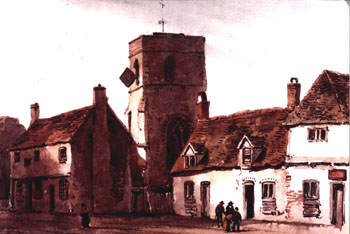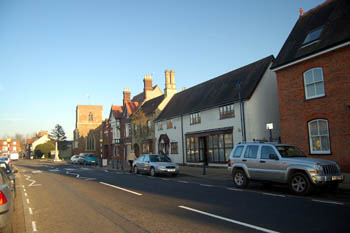Shefford Fair

Shefford High Street about 1820
The Lord of the Manor of Campton-cum-Shefford had the right to hold an annual fair in Shefford as well as a weekly market. The first known charter granting a fair is held in the National Archives at Kew; Bedfordshire Archives has a translation [ref: CRT130Shefford4] which reads: "For Robert de l'Isle: To the Archbishops etc., greetings. Know that we have granted, and by this our charter confirmed to our beloved and faithful Robert de l'Isle, that he and his heirs for ever should hold a fair every year at his Manor of Shafford, co. Beds., for a period of six years, viz., on the eve and on the day of Michaelmas [29th September], and for the four days following, unless this fair should be detrimental to neighbouring fairs. Wherefore we will and firmly command for ourselves and our heirs that the aid Robert and his heirs for ever should hold the said fair at his said manor with all liberties and free customs appertaining to this fair, unless the said fair should be detrimental to neighbouring fairs. Witnesses: the Bishop of Durham, Ranulph de Nevill, Robert de Hilton, Wicher de Charrum, Edmund de Mauley senior, of our household, Thomas de Gykonore, Peter de Denardeston, and others. Dated at Newcastle-upon-Tyne, 15th April". Unfortunately no year is given but it was presumably in or soon after 1312 when Robert came of age and was granted the manor by Edward I, it had been divided between his mother and one Robert de Ispannia since his father's death when he was six.
The fair survived well after the Middle Ages, a case in the State Papers of Charles I for 1636 throws light on a squabble over where stalls might be set up. Clearly, at this time, the Crown let the right to take tolls at the Market, rather than the Lords of the Manor. The published summary being as follows [ref: CRTShefford10]: "Brief of the contents of a bill and answer in a cause between Humphrey Sampson, plaintiff, and Thomas Stephens, Oliver Thody, and others, defendants. The bill alleged, that the Queen's Commissioners by indenture dated 9th June 1625 demised to James Sampson, father of the complainant, the tolls of the markets and fairs in Shefford, co.Bedford, and all shops, stalls, and pickages whatsoever for 21 years, at the rent of £12 a year, by virtue of which lease the plaintiff set up certain stalls, which defendants pulled down and erected others in their stead. In their answer defendants prescribed to set stalls under the railings of their houses, and Stephens confessed that he hindered the plaintiff from setting up a stall which stopped the light of his house".
No other surviving document hints at the site of the fair. Presumably it could be held on any part of the manorial waste, or even on the manor land itself. The abundance of known licensed premises around the junction of Northbridge Street, Southbridge Street and the High Street may be a clue as to the traditional site. In 1681 the market and fair tolls were granted to Timothy Wilson and Elizabeth, his wife.
In 1713 the right to hold not one but three fairs was confirmed to the Lords of the Manor, the Bruce family, Earls of Elgin and Ailesbury [ref: PE441], the charter stating: "the right to hold three fairs annually in Shefford…for the buying and selling of flocks, herds and all manner of goods" these were to be on Easter Monday, 8th May and 12th January - if either of the latter two dates fell on a Sunday the fair was to be held on the following day. At each fair a Court of Pie Powder was also to be held - a manorial court set up to deal with disputes arising directly from and at the fair.
In 1738 the Bruce family sold the lease of the manor to the Dukes of Bedford. The Dukes of Bedford did not renew the lease in 1839 and it thereafter, with the right to hold the fairs, reverted to the Crown. The Traveller's Pocket Book of 1770 records that cattle fairs were held at Shefford on 23rd January, Easter Monday, 19th May and 10th October each year.
The fair continued into the mid 19th century. In 1858 a man named Thomas Handscomb was returning to Ireland, in the parish of Southill, from the fair [ref: QSR1858/4/5/7]. As he passed over Shefford Bridge a woman who was pursuing him caught him up and asked if he was going to the Biggleswade Road. He told her he was not. She then came up close to him, then took hold of him and asked him to buy her a pint of beer. He then felt her hand in his breeches pocket!
By now rather alarmed Handscomb tried to get away from the woman whom, no doubt, he thought was a prostitute. At that moment he was rushed by two men he had not seen, obviously the woman's accomplices. They seized him, held him by the throat and threw him down. The woman ran away towards town and the men went on the road towards Bedford. When he got up he found he had been robbed of his purse containing six shillings and sixpence, and his key. He went into town to look for the woman but could see nothing of her until he got back to the same bridge. He knew her immediately and went up and took hold of her. He accused her of robbing him. The same two men came up and seized him again by the throat and tried to get her away from him. Some other men happened to come out of a nearby public house and the men ran away. He kept the woman there until the police came and he gave her over into custody. In evidence the woman, Susan, wife of Henry Walker of Shefford (was he one of the two men?), said that she had nothing to say except she had not taken the money and that Handscomb had sworn falsely. The Bedford Gaol register [ref: QGV12/1] tells us that Susan Walker was aged 23, she was convicted and served four months hard labour at the prison.
Mid 19th century directories record fairs as late as 1869 - the dates now being 23rd January, 6th April and 19th May for cattle and 11th October "for pleasure". This latter, amusement fair, survived at least until the 1880s - that in 1883 was reported as consisting of "considerably less" stalls and shows than in previous years. The fair of 1885 (on 17th October rather than 11th) was described as: "probably one of the smallest ever held".
 The south side of Shefford High Street, February 2008
The south side of Shefford High Street, February 2008